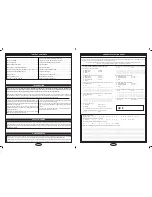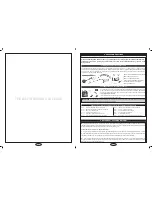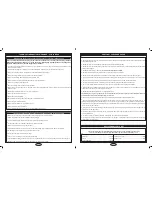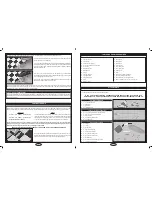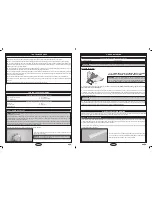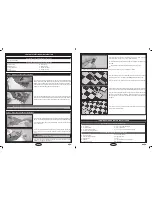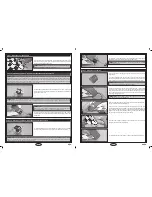
Page 4
Page 17
Please read and understand the warnings listed in this section. Make sure to read any and all warnings included
in the packaging with your battery, too. If used improperly, lithium polymer batteries can be very dangerous,
so please follow these warnings and suggestions at all times.
l
This product may explode or catch fire. Serious injury can result from misuse. Serious injury, loss of property, fire and death can result
from misuse of this product.
l
All instructions, warnings and cautions must be followed at all times. Failure to do so can lead to serious injury or fire.
l
Do NOT use this product before reading and understanding all directions and warnings.
l
Do NOT overcharge. Maximum voltage for each pack must be followed.
l
Do NOT over-discharge. NEVER discharge below minimum volts.
l
Do NOT discharge at a rate greater than the maximum continuous discharge.
l
Do NOT use or charge if the battery is hot.
l
ONLY use a charger made for Lithium Polymer batteries.
l
Do NOT charge at a rate higher than 1C. Example: if the battery’s rating is 340mAH, then the charger’s charge rate must be set at
340mAH or less.
l
Do NOT leave in direct sunlight or in a hot car or storage area.
l
Do NOT get wet or expose to moisture.
l
Do NOT short-circuit the battery.
l
ONLY discharge and charge the battery outdoors or in a firesafe container.
l
Do NOT charge with reverse polarity.
l
Do NOT leave the battery connected when not in use.
l
Do NOT operate or charge unattended.
l
Do NOT solder to the battery directly and do not get the battery hot in any way.
l
Do NOT use the product if you do not understand the warnings and proper use of the product.
l
Always let the battery cool and "rest" between uses and charging.
l
To avoid over-discharging, only use a speed control that is made for LiPO batteries.
l
We recommend the use of a firesafe container when charging or storing.
l
Do NOT charge inside your car or inside your house.
l
Inspect the battery before each use for swelling or other malformation. If the cell has ballooned, it MUST be discarded.
l
Set the charger to 1C (charge at 1/2C or less for the first 5 cycles).
l
Check polarity and then connect battery to charger.
l
In use, do not over-discharge or exceed maximum discharge.
l
When handling the battery, remember not to poke, bend or damage the cells. The cell's outer casing is soft and can be damaged.
l
Remember, the cells must never exceed 160º Fahrenheit (71º Celcius) for any reason.
liThiuM PolyMer bATTery WArNiNGS - PleASe reAd
WArNiNGS ANd SAFeTy PreCAuTioNS For All brANdS oF liThiuM PolyMer bATTerieS
ChArGiNG WArNiNGS ANd PreCAuTioNS For All brANdS oF liThiuM PolyMer bATTerieS
l
Completely charge the transmitter and receiver batteries before your first day of flying.
l
Check every bolt and every glue joint in the aircraft to ensure that everything is tight and well-bonded. This should include all of the
control surface hinges as well.
l
Double-check that you've installed and tightened all of the servo horn retaining screws.
l
Double-check that the receiver, ESC and flight battery are properly secured into place. There's nothing worse than the flight battery
coming loose during flight.
l
Double-check the balance of the aircraft.
Do this with the flight battery installed
.
l
Check the control surfaces. They should all move in the correct direction and not bind.
l
Make sure that you've installed silicone fuel tubing over the clevises to prevent any chance of them opening during flight.
l
If your radio transmitter is equipped with dual rate switches, double-check that they are on the low-rate setting for your first few flights.
l
Check to ensure that all of the control surfaces are moving the proper amount in both low and high rate settings.
l
Check the receiver antenna wire. It should be fully extended and not coiled up inside the radio compartment.
l
Do not cut the receiver antenna wire shorter or the range of your radio control system will be greatly reduced.
l
Properly balance the propeller. A propeller that is out of balance will cause excessive vibration, which could lead to motor and/or
airframe failure, and it will reduce motor efficiency and power.
l
Double-check that the propeller spinner nut is tightened securely.
PreFliGhT CheCK ANd SAFeTy
When it comes time to order replacement parts, we recommend ordering directly from your local hobby retailer.
if your hobby retailer does not stock Model Tech products, you can order replacement parts directly
from your local distributor, using the separate customer Service sheet included with your kit.
rePlACeMeNT PArTS liST
The following are our general guidelines for your safety and the safety of others. Please read and understand these safety
guidelines before going out to the flying field for the first time.
l
Do not test-fly your aircraft for the first time without first having it safety-checked by an experienced modeler.
l
Do not fly your aircraft higher than approximately 400 feet within 3 miles of an airport without having an observer with you. The
observer should tell you about any full-size aircraft in your vicinity and you should always give the right-of-way to full-scale aircraft.
l
When flying at a flying field with established rules, you should abide by those rules. You should not deliberately fly your aircraft in a
reckless and/or dangerous manner.
l
While flying, you should not deliberately fly behind the flight line. If your aircraft should inadvertently fly behind the flight line, you
should change course immediately.
l
You should complete a successful range check of your radio equipment prior to each new day of flying, or prior to the first flight of a
new or repaired aircraft.
l
You should perform your initial turn after take- off away from the flightline and/or spectator area.
l
You should not knowingly operate your R/C radio system within 3 miles of a preexisting model club flying field without a frequency
sharing agreement with that club.
Canopy ............................................................................. 115949
Hatch Cover...................................................................... 115950
Cowling ............................................................................. 115951
Vertical Stabilisers ............................................................ 115952
Decal Set .......................................................................... 115953
Assembly Instructions....................................................... 115954
Hardware Set.................................................................... 115955


